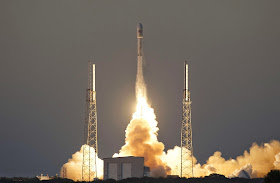SpaceX - Falcon 9 / DSCOVR launch patch.
February 11, 2015
Falcon 9 rocket carrying DSCOVR ready for launch
A new mission to monitor solar activity is now making its way to an orbit one million miles from Earth. The Deep Space Climate Observatory (DSCOVR) launched on a SpaceX Falcon 9 rocket at 6:03 p.m. EST Wednesday from Space Launch Complex 40 at Cape Canaveral Air Force Station in Florida.
DSCOVR Launches Aboard SpaceX Falcon 9
DSCOVR, a partnership among the National Oceanic and Atmospheric Administration (NOAA), NASA and the U.S. Air Force, will provide NOAA space weather forecasters more reliable measurements of solar wind conditions, improving their ability to monitor potentially harmful solar activity.
NASA received funding from NOAA to refurbish the DSCOVR spacecraft and its solar wind instruments for this mission. The work was completed at NASA’s Goddard Space Flight Center in Greenbelt, MD, where a team developed the command and control portion of the spacecraft’s ground segment, and manages the launch and activation of the satellite.
Falcon 9 rocket launched by SpaceX and carrying DSCOVR
Following successful activation of the satellite and check-out approximately 150 days after launch, NASA will hand over operations of DSCOVR to NOAA.
“DSCOVR is the latest example of how NASA and NOAA work together to leverage the vantage point of space to both understand the science of space weather and provide direct practical benefits to us here on Earth,” said John Grunsfeld, associate administrator of NASA’s Science Mission Directorate in Washington.
With DSCOVR in its distant orbit, it will become the nation’s first operational satellite in deep space, orbiting between Earth and the sun at a location called the first Lagrange point, or L1. DSCOVR will join at this orbit NASA’s Advanced Composition Explorer (ACE) research satellite, and replace the 17-year-old satellite as America’s primary warning system for solar magnetic storms. ACE will continue its important role in space weather research.
NOAA management of DSCOVR includes spacecraft operation and distribution of the mission’s space weather data. These data, coupled with a new forecast model scheduled to come online later this year, will enable NOAA forecasters to predict geomagnetic storm magnitude on a regional basis.
Deep Space Climate Observatory (DSCOVR) spacecraft
Geomagnetic storms occur when plasma and magnetic fields streaming from the sun impact Earth’s magnetic field. Large magnetic eruptions from the sun have the potential to bring major disruptions to power grids, aviation, telecommunications, and GPS systems.
In addition to the mission’s primary space weather-monitoring instruments, DSCOVR carries two NASA Earth-observing instruments that will gather a range of measurements from the ozone and aerosols in the atmosphere, to changes in Earth's radiation budget. A NASA solar-science instrument, the Electron Spectrometer, will measure electrons in the solar wind.
The National Institute of Standards and Technology Advanced Radiometer (NISTAR) measures the reflected and emitted energy from the entire sunlit face of Earth. This measurement is intended to improve understanding of the effects of changes in Earth's radiation budget caused by human activities and natural phenomena.
Images of the entire sunlit face of Earth, with ten filter settings in the ultraviolet and visible spectral ranges, are provided by the Earth Polychromatic Imaging Camera (EPIC) instrument on DSCOVR. EPIC's observations will be used to measure ozone and aerosol amounts, cloud height, vegetation properties and ultraviolet reflectivity of Earth.
Data from EPIC will be used to create true-color images of the full sun-facing side of Earth that will be publicly available approximately 24 hours after they are taken. At least six images will be produced each day and posted to the NASA website. The first images will be posted approximately six months after launch.
For more information on the DSCOVR mission, visit: http://www.nesdis.noaa.gov/DSCOVR/
For more information about Dragon resupply spacecraft, visit: http://www.spacex.com/
Images, Video, Text, Credits: NASA/NOAA/SpaceX.
Greetings, Orbiter.ch




